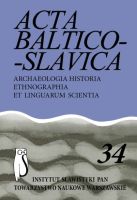The Principles of Making Maps and Commentaries to the Atlas of the Baltic Languages
The Principles of Making Maps and Commentaries to the Atlas of the Baltic Languages
Author(s): Asta Leskauskaitė, Danguole MikulėnienėSubject(s): Language and Literature Studies
Published by: Instytut Slawistyki Polskiej Akademii Nauk
Keywords: atlas languages; Baltic languages; linguistic cartography.
Summary/Abstract: The people in Lithuania and Latvia speak related languages which belong to the Baltic branch. After the restoration of independence of both countries in 1990 it was very important to bring out the similarities which link them. This is how the idea of making an atlas of the Baltic languages evolved. Preparing the Atlas of the Baltic Languages Lithuanian and Latvian linguists hope for the following: 1) to research using the geolinguistics method into what has been common in the Baltic languages; 2) to record the boundaries of the former common area of the living Baltic languages as it was at least at the end of the 20th; 3) to demonstrate the vast variety of the Baltic dialects which have been formed naturally in the course of history; 4) to prove the variance and archaism of the lexicon, phonetics, morphology, word formation, syntax and other linguistic phenomena on the basis of the data obtained from old writings and dialects. The material of the Atlas of the Baltic Languages is not only part of the historical and cultural heritage of the two related nations but also a very valuable treasure of linguistic data on an international level, which can supply much information not only to experts in the Baltic and Slav languages but also to specialists on Indo-European linguistics, ethnography, history, archaeology and other branches.
Journal: Acta Baltico Slavica
- Issue Year: 2010
- Issue No: 34
- Page Range: 57-72
- Page Count: 16
- Language: English

